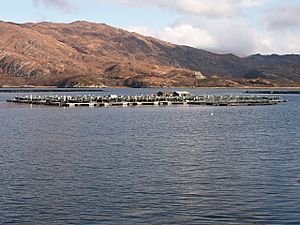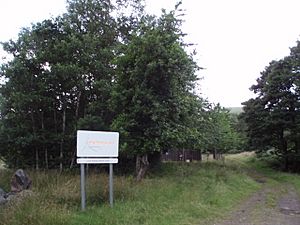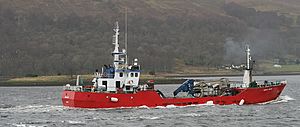Mowi facts for kids
| Allmennaksjeselskap | |
| Traded as | OSE: MOWI |
| Industry | Seafood, food processing |
| Founded | 2006 (current structure) |
| Headquarters | Bergen, Norway |
|
Key people
|
Ivan Vindheim (CEO), Ole Eirik Lerøy (Chair), Leif Frode Onarheim (Deputy chair) |
| Products | Farmed salmon and trout, processing and distribution of seafood |
| Revenue | NOK 27.88 billion (2015) |
| NOK 1.42 billion (2015) Harvest volume of salmonids, tonnes gutted weigh: 420 148 (2015) | |
| Total assets | NOK 40.26 billion (end 2015) |
| Total equity | NOK 18.18 billion (end 2015) |
|
Number of employees
|
12,454 (2015) |
Mowi ASA is a big Norwegian company that works with seafood all over the world. It was known as Marine Harvest ASA until 2019 and Pan Fish before 2007. Mowi's main business is fish farming, especially raising salmon. They have farms in places like Norway, Scotland, Canada, the Faroe Islands, Ireland, and Chile.
Mowi is the largest company in the world for salmon and trout farming. They handle about 25% to 30% of the global market. Mowi also has a special unit that prepares and sells different seafood products.
The company became this large after a big joining of three companies in 2006. These companies were Pan Fish ASA, Marine Harvest N.V., and Fjord Seafood. Mowi's main office is in Bergen, Norway. Its shares are traded on the Oslo Stock Exchange.
In 2023, the company earned about €5.51 billion. This was more than in 2022. Their profit was €444.4 million.
Contents
Mowi's Story
How Mowi Grew
Marine Harvest's Beginnings

The first company called Marine Harvest started in Scotland in 1965. It was created by a company called Unilever. They were pioneers in farming Atlantic salmon. Marine Harvest began farming fish in Chile in 1975.
Over the years, Marine Harvest was bought and sold by different companies. In 1999, a Dutch company called Nutreco bought it. Nutreco kept the name Marine Harvest for its fish farming business. They also started farming other types of fish like cod and halibut.
In 2005, Nutreco combined its fish farming business with another company's seafood operations. This created a new company, also named Marine Harvest.
Pan Fish's Journey
Pan Fish Holding AS started in 1992. Its goal was to buy many fish farms in Norway and other countries. By 1997, Pan Fish was listed on the Oslo Stock Exchange.
However, Pan Fish borrowed a lot of money to grow quickly. When salmon prices dropped in 2001, the company faced big money problems. They had to sell off some of their farms to pay back what they owed. After some changes and new leaders, the company slowly got back on track and started making a profit again in 2005.
Fjord Seafood's Growth
Fjord Seafood began in 1996 with just one fish farm in Norway. It grew very fast over the next four years. By 2000, Fjord Seafood had many fish farms, as well as places to raise young fish and factories for processing.
Like Pan Fish, Fjord Seafood also had financial difficulties when fish prices fell. Major investors had to help the company with money in 2001. Fjord Seafood improved its financial situation by making changes and cutting costs.
The Big Joining of Companies
A rich businessman named John Fredriksen played a big part in bringing these companies together. In 2005, his investment company bought a large part of Fjord Seafood. Around the same time, his companies also bought a big share of Pan Fish.
In March 2006, Fredriksen's company bought Marine Harvest. He then immediately gave ownership of Marine Harvest to Pan Fish. At the same time, he also sold his shares in Fjord Seafood to Pan Fish.
Because of these deals, Fjord Seafood was no longer listed on the Oslo Stock Exchange by July 2006. By the end of 2006, the entire Marine Harvest group was under the control of Pan Fish. To make sure the merger was fair, Pan Fish had to sell off its Scottish division. This division became a separate company called Lighthouse Caledonia in November 2007.
A New Name and Identity
After the companies joined, Pan Fish decided to change its name and image in December 2006. They chose "Marine Harvest" as the new name. They also used parts of the old Fjord Seafood and Pan Fish logos.
The company's leaders changed over the years. In November 2019, Ivan Vindheim became the new CEO of Mowi.
In 2023, Mowi announced plans to make its business more efficient. This included using more automation and making new agreements with suppliers. These changes aimed to save the company money.
How Mowi Operates
Mowi raises Atlantic salmon, halibut, and other freshwater whitefish. The company handles the entire process of fish farming. They start by raising young fish in fresh water. Then, the fish grow and mature in sea water. After that, they are harvested, processed in factories, and sent out for sale. In 2015, Mowi produced over 420,000 metric tons of salmon and trout.
Mowi uses several brand names for its products. Some of these include Delifish, Ducktrap, Clare Island Organic Salmon, and Kritsen.
Where Mowi Produces Fish
Europe
In Norway, Mowi has its main office in Bergen. It operates about 100 sea farms along the coast. They also have many freshwater sites, places to raise young fish, and four processing plants.
In Scotland, Mowi has 25 sea farms. They also have hatcheries (places where fish eggs hatch) and a processing plant in Fort William. Their main office in Scotland is in Rosyth. All the fish produced here is Atlantic salmon.
In the Faroe Islands, Mowi has freshwater and seawater farms. They produce Atlantic salmon there.
In Ireland, Mowi has farms and processing plants. Most of these are in County Donegal. They also produce Atlantic salmon.
America
In Chile, Mowi operates 53 seawater farms and 22 freshwater sites. They also have four processing plants. Their main office in Chile is in Puerto Montt. They produce salmon, trout, and coho salmon there.
In British Columbia, Canada, Mowi has two processing plants, seven hatcheries, and 37 seawater farms. These are located near several towns. They produce Atlantic salmon in Canada.
In Atlantic Canada, Mowi bought a hatchery and fishing licenses in New Brunswick in 2017. They also bought a processing plant and fishing licenses in Newfoundland.
Processing and Sales Locations
Mowi has processing and distribution plants in France, Belgium, and the Netherlands. They also have sales offices in Italy and Spain.
In the United States, Mowi has processing plants in Maine and Texas. They also have sales offices in Miami. In Asia, Mowi has sales offices in Singapore, China, Japan, Taiwan, and South Korea.
Challenges and Safety
Mowi has faced some challenges and criticisms related to its fish farming operations.
In Chile, many fish at Mowi's farms became sick with a disease called infectious salmon anemia. This disease spread quickly. To deal with this, Mowi sold some of its farms and moved others further south. A company spokesperson said they were using too many antibiotics in Chile. They also noted that fish pens were too close together, which helped the virus spread.
In 2017, it was reported that Mowi was using a lot of a medicine called azamethiphos in Scottish waters. This medicine helps control sea lice on salmon. Some groups asked for the medicine to be banned because of possible risks to other sea creatures.
In 2019, an Irish minister stopped a fish farm license for Mowi in County Kerry. This was because the farm had too many fish.
In 2020, a serious accident happened at a Mowi farm in Scotland. A worker was badly injured and drowned. An investigation looked into Mowi's safety procedures. It suggested that Mowi should get advice from marine experts and improve its safety system. Mowi has been working to improve safety and reduce risks in its operations.



